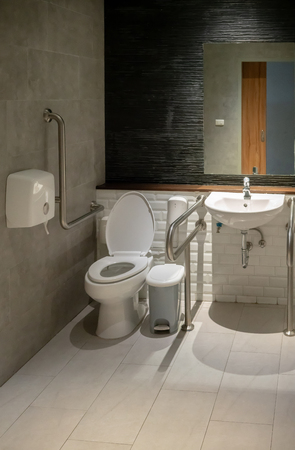Introduction to Accessible Bathrooms in the UK
Accessible bathrooms are an essential aspect of modern home adaptations, particularly for those undergoing rehabilitation after injury, surgery, or as part of ageing in place. In the UK, where housing stock is characterised by a mix of period properties, post-war builds, and newer developments, creating accessible bathrooms presents unique challenges and opportunities. The importance of making bathrooms accessible extends beyond mere convenience; it directly impacts safety, independence, and quality of life during the rehabilitation process. UK-specific factors such as narrow hallways, multi-storey layouts, and compact bathroom spaces often require tailored solutions that comply with local building regulations and standards like Part M of the Building Regulations. As awareness grows around inclusive design and the rights of disabled individuals under the Equality Act 2010, adapting bathrooms for safe home rehabilitation has become a priority for homeowners, carers, and healthcare professionals alike. This article will explore how thoughtful design and practical modifications can transform traditional British bathrooms into safe, accessible spaces that support recovery and dignity at home.
Key Accessibility Features for British Homes
When adapting home bathrooms for safe rehabilitation in the UK, it is essential to consider features that accommodate both the unique needs of individuals and the typical layout of British homes. Many British properties, especially older terraced or semi-detached houses, have compact bathrooms with limited space. Therefore, selecting and integrating the right accessibility features can make a significant difference in ensuring safety, comfort, and independence.
Essential Accessible Bathroom Features
| Feature | Description | Suitability for UK Homes |
|---|---|---|
| Walk-in Showers | Step-free entry showers that allow easy access, often with a level floor throughout. | Ideal for narrow bathrooms common in Victorian or Edwardian terraces; can replace traditional bathtubs to maximise space. |
| Grab Rails | Secure bars installed near toilets, showers, and baths to aid movement and stability. | Easily fitted to existing walls and essential for safety in small spaces where manoeuvrability is limited. |
| Anti-slip Flooring | Specialised flooring materials that reduce the risk of slips, even when wet. | Particularly important for tiled floors found in many UK homes; available in various finishes to suit décor. |
| Raised Toilets | Toilets with increased seat height to facilitate easier sitting and standing. | Helpful in compact cloakrooms or main bathrooms; can be retrofitted without major structural changes. |
Adapting to Common UK Housing Layouts
Given the prevalence of small bathrooms and tight corridors in British homes, careful planning is necessary when installing accessible features. For example, replacing a bath with a walk-in shower can free up valuable floor space. Likewise, strategically placed grab rails can be fitted even in confined areas without obstructing movement. Anti-slip flooring is crucial due to the frequent damp conditions caused by limited ventilation in older properties. Raised toilets are particularly beneficial for those with mobility issues, as they reduce strain on joints and promote safer transfers. By understanding both the theory behind these adaptations and their practical application within the context of UK housing, homeowners can create safer environments tailored to rehabilitation needs.
![]()
3. Adapting Existing Bathrooms: Practical Solutions
Adapting a standard British bathroom for accessibility need not require a complete overhaul. Many homeowners in the UK, particularly those living in terraces, flats, or semi-detached houses, face unique challenges such as limited space and tight budgets. However, with careful planning and practical modifications, it is possible to create a safe and accessible environment suitable for rehabilitation without compromising on style or comfort.
Cost-Effective Modifications for Every Home
Begin by identifying key areas where support and safety are paramount. For most British bathrooms, the addition of grab rails beside the toilet and inside the shower or bath can provide immediate assistance for those with reduced mobility. These are both affordable and easy to install, requiring minimal disruption to existing tiles and fixtures. Where possible, opt for rails with a non-slip coating, which is particularly beneficial in damp environments common to UK homes.
Space-Saving Adaptations for Compact Layouts
Space constraints in British properties often make large-scale renovations impractical. Instead, consider compact solutions like wall-mounted fold-down shower seats or corner basins. These adaptations maximise available floor area while ensuring essential features remain accessible. Replacing a traditional bathtub with a low-threshold shower enclosure can significantly improve accessibility without demanding extra space—many suppliers offer units designed specifically for narrow bathrooms found in older terraces and flats.
Smart Fixtures and Fittings
Modern accessible fittings have been designed with both practicality and British tastes in mind. Lever-style taps are easier to operate than conventional twist taps, especially for individuals with arthritis or limited dexterity. Raised-height toilets are another effective upgrade that makes sitting and standing more manageable. Importantly, these fixtures are now widely available from major UK retailers at various price points, making them an attainable option for most households.
Planning for Future Needs
If you anticipate changing requirements over time—such as progressive mobility loss—it’s wise to invest in adaptable designs from the outset. Removable or modular fittings allow you to update your bathroom as needs evolve, minimising future expense and upheaval. Consulting with occupational therapists or local council advisors can also help identify the most suitable modifications specific to your property type and personal situation.
Navigating Planning Permissions and Grants
In many cases, minor adaptations do not require planning permission; however, listed buildings or significant alterations may necessitate approval from your local authority. It is worth investigating whether you qualify for government grants such as Disabled Facilities Grants (DFG) to offset some costs—a valuable resource for eligible UK residents undertaking essential home adaptations.
By focusing on practical, cost-effective solutions tailored to British homes’ unique characteristics, it is entirely feasible to transform standard bathrooms into accessible spaces that promote safe rehabilitation and long-term independence.
Safety Measures and Best Practices
Ensuring bathroom accessibility during rehabilitation goes beyond basic adaptations; it requires strict adherence to established safety standards and best practices. In the UK, this means referencing British Standards (such as BS 8300) and NHS guidelines to promote both usability and security within the home environment.
Preventing Slips and Falls
Slips and falls are among the most common causes of injury in bathrooms, particularly for individuals with reduced mobility or balance issues. To mitigate these risks, a combination of anti-slip flooring, strategically placed grab rails, and clear spatial layouts is essential. The table below outlines recommended features and their corresponding British Standards:
| Feature | Purpose | Relevant British Standard |
|---|---|---|
| Anti-slip flooring | Reduces risk of slipping, even when wet | BS 7976-2 |
| Grab rails (fixed securely) | Provides support for standing and moving | BS 8300:2018 |
| Clear floor space | Allows unobstructed wheelchair or carer access | BS 8300:2018 |
| Tactile surfaces/contrasting colours | Aids those with visual impairments in navigation | BS 8493:2008+A1:2010 |
Safe Transfers and Supportive Fixtures
The process of transferring from a wheelchair or mobility aid to the toilet or shower should be as seamless as possible. This relies on well-positioned support fixtures that comply with British Standard recommendations. For example, drop-down support rails next to toilets and height-adjustable shower seats can significantly reduce the strain on users and carers alike. It is also vital to ensure that all fixtures are securely installed by qualified professionals familiar with UK regulations.
Key Practices for Safe Transfers:
- Install wall-mounted or fold-down shower seats at appropriate heights (typically 480mm–500mm from floor level).
- Select thermostatically controlled mixer taps to prevent scalding.
- Ensure that grab rails are positioned at consistent heights and are able to withstand adequate load-bearing (minimum 150kg as per BS 8300).
- Keep transfer spaces free from trip hazards such as loose mats or exposed pipework.
The Importance of British Standard-approved Fixtures
Opting for products that carry a British Standard Kitemark ensures rigorous testing for durability, safety, and accessibility. Whether choosing lever-operated taps, comfort-height toilets, or accessible basins, confirming compliance not only supports safe rehabilitation but also provides peace of mind regarding long-term use.
5. Support, Grants, and Local Authority Guidance
For many UK residents, adapting a bathroom to meet accessibility needs can seem financially daunting. Fortunately, there is a range of support mechanisms available to help make accessible bathrooms a reality for those who need them most. Understanding the various forms of assistance, from government grants to local council services, is crucial when planning safe and effective home rehabilitation.
Disabled Facilities Grants (DFGs)
The Disabled Facilities Grant is one of the primary sources of financial support for accessible bathroom adaptations in England, Wales, and Northern Ireland. This means-tested grant is provided by local authorities to eligible individuals with disabilities to help cover the cost of essential adaptations, such as installing level-access showers, handrails, or specialist toilets. The maximum amount available varies depending on the location and individual circumstances, but applying for a DFG can significantly reduce the personal financial burden associated with making a bathroom safer and more accessible.
Eligibility and Application Process
To qualify for a DFG, applicants must be either disabled themselves or have someone living in the property who is disabled. A formal assessment by an occupational therapist is usually required to determine the specific adaptations needed. Once approved, the local council will manage or oversee the work to ensure it meets current standards for accessibility and safety.
Local Authority Services and Advice
Beyond grants, local councils offer valuable advice and practical support through their social care and housing departments. Many councils provide home assessments free of charge and can recommend reputable contractors experienced in accessible adaptations. In some cases, councils may also offer low-interest loans or additional funding streams for those who do not fully qualify for grants but still require assistance.
Additional Support Channels
Charities such as Age UK and Scope also provide guidance on navigating available support options. They often have helplines or online resources that explain how to apply for financial aid and what documentation may be necessary. Engaging with these organisations early in the planning process can help households identify all possible avenues of assistance.
Maximising Available Resources
Ultimately, combining government grants with expert advice from local authorities ensures that every adaptation project meets both legal requirements and personal needs. Taking advantage of these resources can make the process of creating an accessible bathroom smoother, more affordable, and tailored specifically to facilitate safe rehabilitation at home.
6. Collaborating with Professionals
Creating an accessible bathroom that meets both safety and rehabilitation needs requires more than just thoughtful design; it demands the expertise of a range of UK-based professionals. By working collaboratively with occupational therapists, building professionals, and reputable local installers, you can ensure adaptations are not only functional but also fully compliant with British standards and regulations.
Occupational Therapists: Personalised Assessment and Guidance
Occupational therapists (OTs) play a pivotal role in assessing the unique requirements of individuals who need accessible bathrooms. They conduct home visits, evaluate mobility challenges, and recommend specific adaptations tailored to each person’s rehabilitation journey. In the UK, OTs are often linked with NHS or local council services, providing evidence-based advice on features such as grab rails, shower seating, and non-slip flooring. Their involvement ensures that any modifications support safe movement and maximise independence.
Building Professionals: Ensuring Structural Integrity and Compliance
Once a plan is established, experienced builders and tradespeople are essential for translating recommendations into practical solutions. Working with professionals familiar with UK Building Regulations—particularly Part M, which addresses access to and use of buildings—is critical for ensuring safety standards are met. These specialists handle tasks such as widening doorways, installing level-access showers, and adjusting plumbing systems to accommodate accessible fixtures. Engaging qualified builders helps prevent costly mistakes and guarantees long-term durability.
Local Installers: Quality Craftsmanship and Aftercare
The success of an accessible bathroom adaptation hinges on choosing reputable local installers with proven experience in disability adaptations. Trusted installers source high-quality products from recognised suppliers and provide professional fitting services while respecting your home environment. Many offer aftercare packages or maintenance checks to ensure ongoing safety and comfort. Checking references, reviews, or accreditations such as those from the Federation of Master Builders or TrustMark can provide peace of mind when selecting an installer.
Coordinated Approach for Best Results
A coordinated approach—where OTs advise on needs, building professionals manage technical aspects, and skilled installers deliver the finished product—creates seamless, regulation-compliant adaptations. This collaborative process not only meets legal requirements but also prioritises user comfort, dignity, and long-term rehabilitation outcomes within the British context.
7. Promoting Independence and Wellbeing
Accessible bathroom adaptations play a fundamental role in supporting safe rehabilitation at home, particularly within the UK’s person-centred care landscape. By focusing on individual needs and preferences, these modifications foster greater independence for those recovering from injury or living with mobility challenges. Features such as level-access showers, easy-grip taps, and strategically placed grab rails not only minimise the risk of slips and falls but also enable users to manage daily routines without reliance on constant assistance.
From a theoretical perspective, empowerment is central to contemporary rehabilitation practices in the UK. Accessible bathrooms exemplify this by providing an environment where individuals can maintain personal hygiene with dignity, which is essential for psychological wellbeing. The ability to control one’s own care routine directly impacts self-esteem and motivation during recovery.
Moreover, a person-centred approach ensures that adaptations are tailored to unique circumstances—whether this involves height-adjustable basins for wheelchair users or thermostatic controls for those with sensory impairments. Occupational therapists and other healthcare professionals collaborate closely with individuals and their families to assess requirements, ensuring that every modification enhances autonomy rather than imposing limitations.
In practical terms, accessible bathrooms reduce the burden on carers and NHS resources by decreasing the need for residential care or hospital readmissions due to preventable accidents. This approach aligns with wider UK health policy goals of promoting community-based rehabilitation and supporting people to live independently in their own homes for as long as possible.
Ultimately, accessible bathroom adaptations are not merely about physical changes; they represent a commitment to upholding dignity, choice, and quality of life. By integrating thoughtful design and person-centred planning, homes across the UK can become truly supportive spaces that encourage recovery, independence, and lasting wellbeing.


